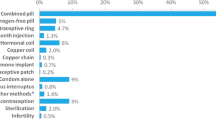Abstract
Emergency contraception (EC) has recently become available, accepted and widely used in Sweden but little is known about the characteristics and background factors of women requesting EC.
Methods: During a four-month period, consecutive women (n=762) visiting family planning clinics to request emergency contraception filled out a questionnaire about their current need for EC.
Results: The user of emergency contraception was typically a nulligravid young woman (83%) but 13% had a previous history of at least one induced abortion and 4% had given birth in the past. One out of four had used EC before, and of these 20% more than once. Condom breakage was the major reason for the current need for EC but as many as 37% had not discussed the need for contraception prior to intercourse. Friends were the most important source of knowledge about EC.
Conclusion: Women requesting emergency contraception could be anyone and emergency contraception is used to compensate for contraceptive failure in order to prevent unwanted pregnancies.
Similar content being viewed by others
References
Rogala C, Anzén B. Late start for emergency contraception in Sweden. Plann Parenthood Eur. 1996;24:15–17.
Pyett P. Postcoital contraception: who uses the “morning after pill”. Aust NZ J Obstet Gynaecol. 1996;36:347–50.
Evans JK, Holmes A, Browning M, Forster GE. Emergency hormonal contraception usage in genitourinary medicine clinic attenders. Genitourin Med. 1996;72:217–19.
Liljestrand J, Josefsson GB, Brannstrom M. Characteristics of young female smokers in a Swedish primary health care area. Scand J Prim Health Care. 1993;11:157–60.
Rahm V, Odlind V, Pettersson R. Chlamydia trachomatis in sexually active teenage girls. Genitourin Med. 1991;67:157–60.
Andersson-Ellström A, Forsmann L, Milsom I. Age of sexual debut to life style and reproductive health factors in a group of Swedish teenage girls. Acta Obstet Gynaecol Scand. 1996;75:484–9.
Harper CC, Ellertson CE. The emergency contraceptive pill: a survey of knowledge and attitudes among students at Princeton University. Am J Obstet Gynecol. 1995;173:1438–45.
Weisberg E, Fraser I, Carrick S, Wilde F. Emergency contraception. General practitioner knowledge, attitudes and practices in New South Wales. Med J Aust. 1995;162:136–8.
Crenin MD. A reassessment of the efficacy of the Yuzpe regimen of emergency contraception. Hum Reprod. 1997;12:496–8.
WHO Task Force on postovulatory methods of fertility regulation. Randomised controlled trial of levonorgestrel versus the Yuzpe regimen of combined oral contraceptives for emergency contraception. Lancet. 1998;352:428–33.
Author information
Authors and Affiliations
Rights and permissions
About this article
Cite this article
Tydén, T., Wetterholm, M. & Odlind, V. Emergency Contraception: The User Profile. Advances in Contraception 14, 171–178 (1998). https://doi.org/10.1023/A:1006604214517
Issue Date:
DOI: https://doi.org/10.1023/A:1006604214517




